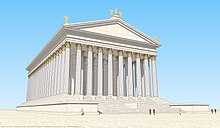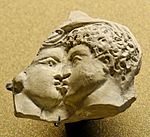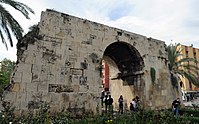Tarsos in Cillcia,400 BC. AR 3/4 Obol-Asia Minor, ICG VF30. Shipped with USPS First Class Package.Foundation and prehistoryEdit
Excavation of the mound of Gözlükule revealed that the prehistoric development of Tarsus reached back to the Neolithic Period and continued unbroken through the Chalcolithic and Early Bronze Ages.
The settlement stood at the crossing of several important trade routes linking Anatolia to Syria and beyond. Because most of the ruins lie under the modern city, archaeology has barely touched the ancient city. As an important port in a merchant marine trade network spanning the eastern Mediterranean and beyond from before the third millennium, the city was always an important centre for cultural interchange with traces of its influence visible from pre-Homeric Greek evidence onwards. The city may have been of Anatolian or Semitic origin; it is first mentioned as Tarsisi in Neo-Assyrian records of the campaigns of Esarhaddon, as well as several times in the records of Shalmaneser I and Sennacherib, the latter having had the city rebuilt. A Greek legend connects it with the memory of the Assyrian king Sardanapalus (Ashurbanipal), still preserved in the Dunuk-Tach, called 'tomb of Sardanapalus', a monument of unknown origin. During the Hellenistic era it was a centre for exchange between Neo-Platonic, Gnostic and Mystery traditions.
Stephanus of Byzantium quotes Athenodorus of Tarsus on another legend:
Anchiale, daughter of Iapetus, founded Anchiale (a city near Tarsus): her son was Cydnus, who gave his name to the river at Tarsus: the son of Cydnus was Parthenius, from whom the city was called Parthenia: afterwards the name was changed to Tarsus.
Much of this legendary account of the foundation of Tarsus, however, appeared in the Roman era, and it is not reliable. The geographer Strabo states that Tarsus was founded by people from Argos who were exploring this coast. Another legend claims that Bellerophon fell off his winged horse Pegasus here, hurting his foot in the process, and that the city was named tar-sos (the sole of the foot) in memory of his accident. Other candidates for legendary founder of the city include the hero Perseus and Triptolemus, son of the earth-goddess Demeter, doubtless because the countryside around Tarsus is such good farmland. Later the coins of Tarsus bore the image of Hercules due to another tale in which the hero was held prisoner here by the local god Sandon. Tarsus has been suggested as a possible site for the biblical Tarshish, to which the prophet Jonah wanted to flee, but Tartessos in Spain has also been offered as a possible location for this.
Early Antiquity, Greece and Persia
In historical times, the city was first ruled by the Hittites, followed by Assyria, and then by the Persian Empire. As the principal town of Cilicia, Tarsus was the seat of a Persian satrapy from 400 BC onward. Indeed, Xenophon records that in 401 BC, when Cyrus the Younger marched against Babylon, the city was governed by King Syennesis in the name of the Persian monarch.
At this period the god of the city was Sandon, of whom a large monument existed at Tarsus at least until the 3rd century AD. Coins showed Sandon standing on a winged and horned lion, and it is now thought likely that the Lion of Saint Mark on the pillar in the Piazza San Marco in Venice was in origin a winged lion-griffin copied from such a monument in Tarsus.
Alexander the Great passed through with his army in 333 BC and nearly met his death here after bathing in the Cydnus. By this time Tarsus was already largely influenced by Greek language and culture, and as part of the Seleucid Empire it became more and more Hellenised. Strabo praised the cultural level of Tarsus in this period with its philosophers, poets and linguists. The schools of Tarsus rivalled those of Athens and Alexandria. A reference in the Bible (2 Maccabees (4:30)) records the city's revolt against Antiochus IV Epiphanes in about 171 BC .The king had renamed the town Antiochia on the Cydnus although the name did not stick due because too many cities were named Antioch. At this time the library of Tarsus held 200,000 books, including a huge collection of scientific works.
Roman period
The huge Temple of Tarsus, one of the largest and most important in antiquity
Oscillum depicting a couple kissing. Terracotta figurine made in Tarsus, Roman Era.
Roman road in Tarsus
After crushing the feared Cilician pirates, Pompey brought Tarsus under Roman rule In 67 BC, and it became the capital of the Roman province of Cilicia.To flatter Julius Caesar, it was briefly named Juliopolis; this was also where Cassius Longinus planned to kill him as early as 47 BC. It was also here that Cleopatra and Mark Antony met and was the scene of the celebrated feasts they gave during the construction of their fleet (41 BC). In William Shakespeare's 1606 play Antony and Cleopatra (Act 5, Scene 2) Cleopatra says she is going to Cydnus to meet Antony after his death, (i.e., she will commit suicide to meet him in the afterlife). "Go fetch / My best attires: I am again for Cydnus, / To meet Mark Antony."
Cleopatra's Gate in Tarsus
In the Roman period, the city was an important intellectual centre, boasting its own academy. One of its leading lights, the philosopher Athenodorus Cananites, was the tutor of the first Roman emperor, Augustus, a fact which secured continuous imperial patronage for the city.
When the province of Cilicia was divided, Tarsus remained the civil and religious metropolis of Cilicia Prima, a grand city with palaces, marketplaces, roads and bridges, baths, fountains and waterworks, a gymnasium on the banks of the Cydnus, and a stadium. Tarsus was later eclipsed by nearby Adana but remained important as a port and shipyard. Several Roman emperors were interred here: Marcus Claudius Tacitus, Maximinus II and Julian the Apostate, who planned to move his capital here from Antioch if he returned from his Persian expedition
- John fl. 979 (Jacobite bishop)
- Athanasius fl.1141 (Jacobite bishop)
- Athanasius II fl.1264 (Jacobite bishop)



